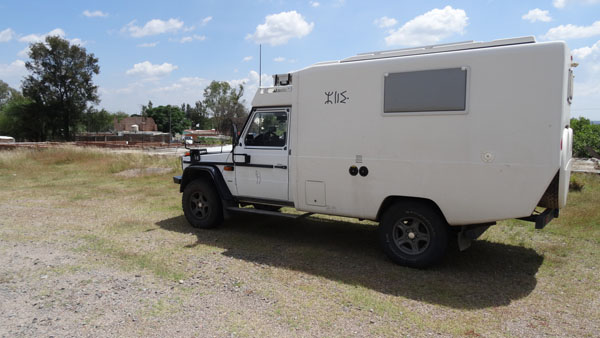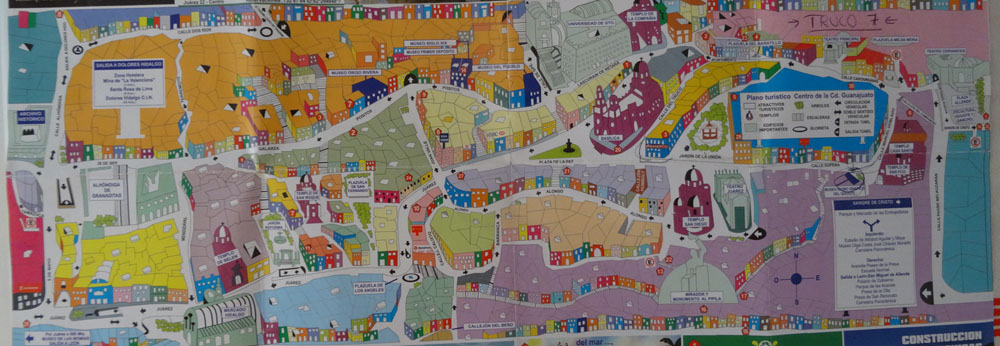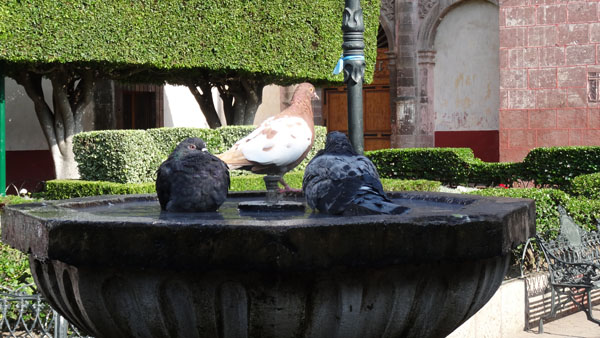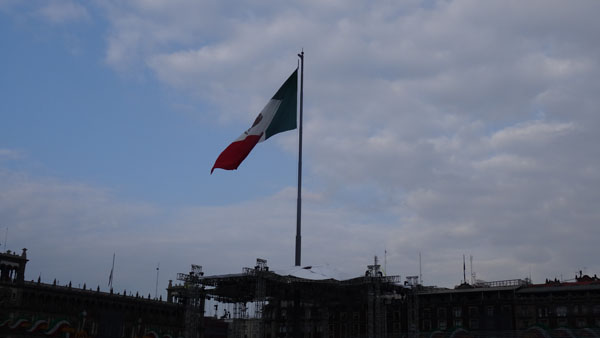Silao, road #45
On Monday, September 7th I left the Trailer Park in San José del
Tajo around 8:00 forecasting of a congestions on the access roads to
Guadalajara which I could not avoid to take the southern peripheral
in the direction to Guanajuato target of my day trip. Of course I
did not go to the city because on Mondays all the museums are closed
and in addition it is difficult to access and to drive. I found a
bivouac around 40 km on the road #45 little before Silao on a flat
ground which must be used as football field by children of the
village. Altitude is of 1813 meters high by GPS.
Guanajuato, GT
Monday evening around 21:30 cars of the municipal police surrounded
my vehicle and torches illuminated it. Approximately five to six
heavily armed men struck to awake me. They put to me the usual
questions in Spanish and in approximate English. I understood that I
could not remain because the vicinity was not sure: “People
Iznogood”. I followed them to a Pemex petrol station where I passed
the remainder of the night, a little noisy. I was to approximately
40 km from Guanajuato where I knew the very problematic parking. I
traversed the downtown area of which famous tunnels without anything
to find. I questioned a driver of a truck of Bimbo delivery which
proposed to me to follow it. But the guard of the carpark refused
because of the height of the vehicle, 2.5 meters. Finally a
motorcyclist told me to follow it. We climbed the surrounding hills
to arrive at Morrill Trailer Park at 2075 meters of altitude where I
could station free for a day and spend the night for 100 pesos. I
gave 20 pesos of tip to the motorcyclist. At 9:00 I began the visit
of the city, registered at the inheritance world of humanity, while
going down to 1800 meters. For the visit I adopted the step of the
Alpine solders! Museo Regional of Guanajuato Alhondiga de Granaditas
is lodged in an old building of grain storage builds in 1798 then
transformed into fortress. It is a parallelepiped with high walls.
The staircases are covered with murals by Jose Chavez Morado. It
exhibits also prehispanic antiquities, paintings by Bustos. At the
ground floor a vibrating homage is dedicated to the heroes of
Mexican independence. Basilica de Nuestra Señora de Guanajuato is
very local color. The university of Guanajuato has an architecture
marrying the slopes of the hill, it has approximately 20,000
students. Museo del Pueblo de Guanajuato is located in the old
mansion of San Juan de Rayas whose baroque vault of 1696 has mural
panels by Jose Chavez Morado. It exposes also paintings of very
interesting Mexican artists, but alas No Photo. Museo Iconografico
del Quijote is devoted to the work of Cervantès, Don Quichotte de la
Manche and Sancho Pansa; impassioning. Then I took a long walk in
the streets of the historical center without forgetting El Jardin. I
returned on foot to the bivouac, slowly.
Centro Historico, click la photo
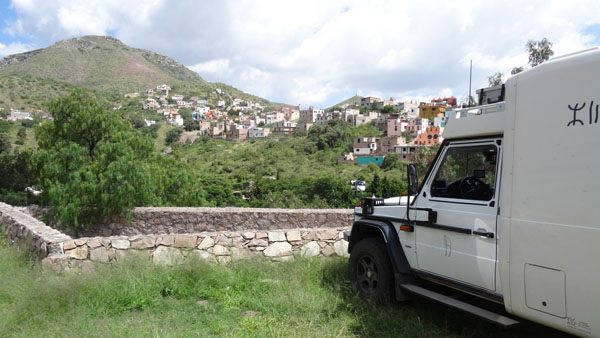
|
| Bivouac, Morrill Trailer Park, 2075 m high |
San Miguel de Allende, GT
On Wednesday morning the visit of San Miguel de Allende was fast.
The downtown area is circumscribed around El Jardin whose size of
the trees is as remarkable as in Guanajuato. It is located at 1900
meters of altitude and account approximately 70,000 inhabitants. The
comment by Lonely Planet is eloquent: “San Miguel is a bit like a
Mexican Disneyland for foreign, mainly American”. The cathedral
resembles a cake of marriage. Beside Museo Historico de San Miguel
is lodged in the native house of Ignacio of Allende. The tourist
office indicated to me that El Jardin is covered by a Wifi
connection. I returned to my vehicle to take my computer. While
arriving a police officer was on the point of putting a ticket for
awkward stationing . After discussion it let me leave, no Wifi! I
wandered in the narrow, quadrangular streets and of prohibited
direction of the old San Miguel to find the exit towards Querétaro.
Finally on the road #45 I stopped to take a frugal lunch. Then
further on I found on the left a nice Pemex petrol station at 2094 m
of altitude where I asked for the authorization of spend the night.
Centro Historico, click la photo
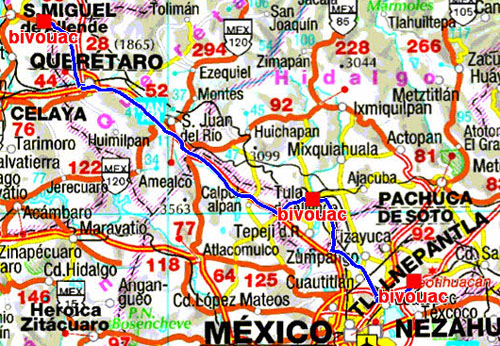
The GPS road tacklog
From
San Miguel de Allende to Teotihuacan
From 2015/09/10 au 2015/09/13
Querétaro, QE
After a very calm night at the Pemex petrol station closed around
21:00 I left as of early dawn to traverse the 54 km separating from
Querétaro where I entered by the road #57 then by the avenida
Zaragoza. I had thrown my reserved on the park Alameda Hidalgo to
find a parking close to the historical center. I outline then on a
wall a panel indicating a carpark. After discussion with the guard
he accepted my vehicle in this carpark in open air, rare. It was
9:00; I began the visit of this town of +800,000 inhabitants at 1800
meters of altitude whose historical center very restricted with the
quadrangular streets and direction-single is surrounded by broad
avenues making traffic fluid. I discovered that the trees
surrounding the gardens sumptuously cut were it with the machete by
men in balance on ladders; they should not be syndicated in local
CGT! Sights are very few and are grouped close to the Zenea garden.
Templo de San Francisco is very coloured outside whose dome is
covered with tiles coming from Spain in 1540. Beside Museo Regional
is lodged in what was a huge monastery and seminar dating back to
1540. The ground floor exhibits prehispanic antiquities whose
museography is very didactic and carries out a good introduction to
the future visits. The other levels are devoted to the conquest of
the area by Spanish accompanied by the various religious orders: Con
Cruz y Espada. Then a broad space is dedicated to the independence
of Mexico, to the Mexican-American war as well the imperial
adventure financed by England, France and Russia. I finished my
visit by paying homage to Corregidora, dona Josefa Ortiz,on his
mausoleum. The aqueduct which crosses the city was not built by the
Romans!
Centro Historico, click la photo
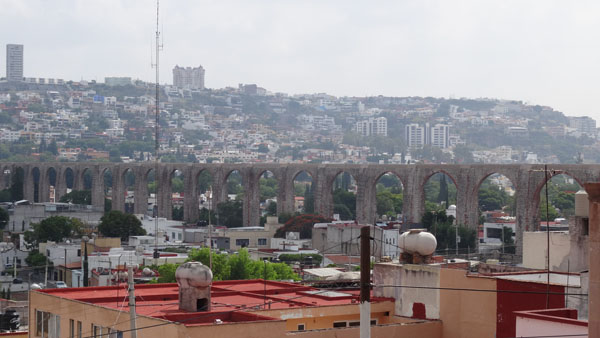
|
| Acueducto |
Tula, HG
On Friday, September 11th as of 9:00 I entered on the site of Tula,
old capital of the Toltec empire from 900 to 1150 AD. The site is
very known by its Pyramid B with its four columns of warriors who
supported the roof of the temple of Quetzalcoatl. North of the
pyramid Coatepantli exhibits engravings of the human sacrifices
offered to the snakes devouring the skeletons. Around the pyramid
the complex develops in Palacio Quemado, Gran Vestibulo, Juego de
Pelota. The museum exhibits statues, sculptures as well as ceramics
from the site. After having lunched on the spot I moved towards the
site of Teotihuacan to install me for several days at the Trailer
Park Teotihuacan where I met a young German couple who gave me full
information to visit Mexico City.
Zona Arqueologica, click la photo
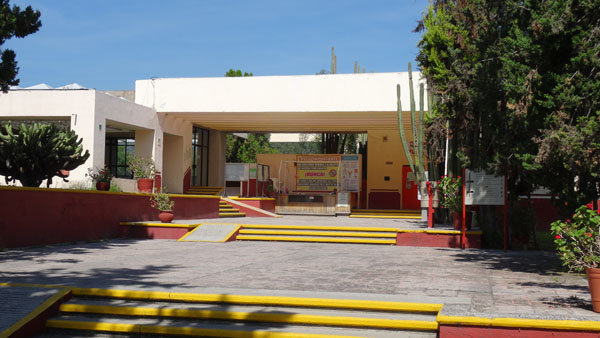
|
| Museum |
Mexico City
On Saturday, September 12th I took a bus for Mexico City where I
arrived at the terminal of Autobuses del Norte, subway station,
after approximately an hour of way. The subway led me to Zocalo
where I immediately sought a hotel for one night in order to not
return to Teotihuacan. As all the subways in the world that of
Mexico City requires the trip of corridors, of staircases going up
and going down and sometimes, seldom, of the escalators. But here
the difference is that this town of +20 million inhabitants is
located at 2240 meters of altitude. Fichtre! It is better to take
time to traverse them. The hotel recommended by Lonely Planet had a
room of free with a common bathroom for three rooms, I reserved it.
Then I began the visit of the historical center with Zocalo and the
cathedral then Templo Mayor which was excavated after the
destruction of a colonial building. The contiguous museum was
inaugurated in 1987, it was thus a discovery for me.
Zocalo & Templo Mayor, click la photo
City Walk, click la photo
At the beginning of afternoon I traversed City Walk recommended by LP.
The avenida Madero is dominated by Torre Latinoamaricana and the crowd
of the Mexicans strolling. Throughout this avenue with animations
attract people. And oh surprised close to Palacio Bellas Artes a
manifestation of men in slipway and women topless danced by stressing
slogans printed on banners. Ah these Latinos! Crossing Central Alameda
and its fountains I visited Museo Mural Diego Rivera. On the trip I
entered in Cantina Tio Pepe already existing before 1869. I was at the
bar and against all recommendations by the medical community I ordered
Margarita whom I enjoyed slowly. Then it was Mercado San Juan and its
tables of seafood tasting. After the Chinese district it was the Regina
Corridor and its eateries. Back to the hotel around 18:00 I rested
during half an hour before going to dine in Plaza Garibaldi and its
Mariachis of which I had not had a good memory. I must say that it
became poor earlier.
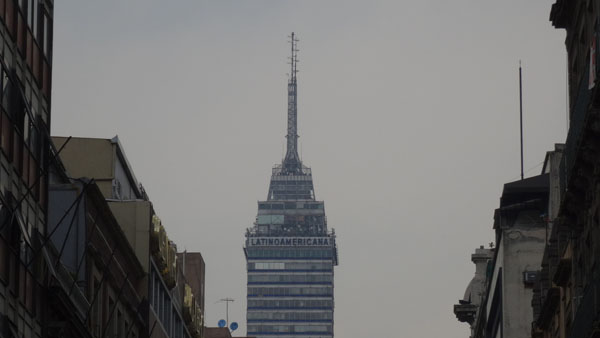
|
Museo Nacional de Antropologia, click la photo
After a good night of rest on Sunday morning I took again the subway to
go to visit Museo Nacional de Antropologia which we had seen in 1984. It
is always one of the most beautiful museums in the World. Only the
environment evolved much in 30 years. In four hours I visited only the
rooms dedicated to the prehispanic cultures. Moreover my compact camera
Sony broke down from battery which is not interchangeable. I left with
regret this splendid museum richly equipped with an extraordinary
museography. In the subway I had become acquainted with a Mexican and of
his little girl who went to the museum, he proposed to me to follow it
to go there. Then we separated for the visit. But surprised we found
ourselves in the subway of the return. I shine explained where I went
and by which circuit of the subway. Whereas it left me, it entrusted to
me with other people fearing that I lose myself. Ah these Latinos, what
kindness. But is they really Latin? Admittedly for the language and the
religion, but for the remainder they are multiethnic.
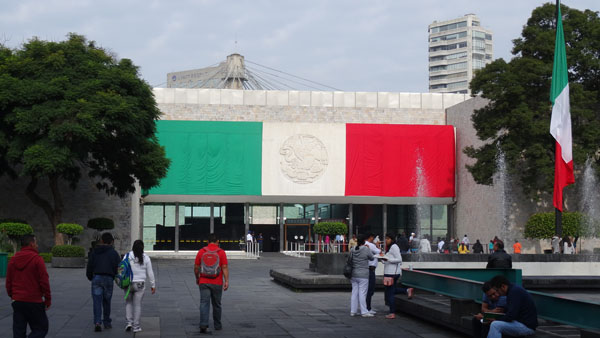
|

